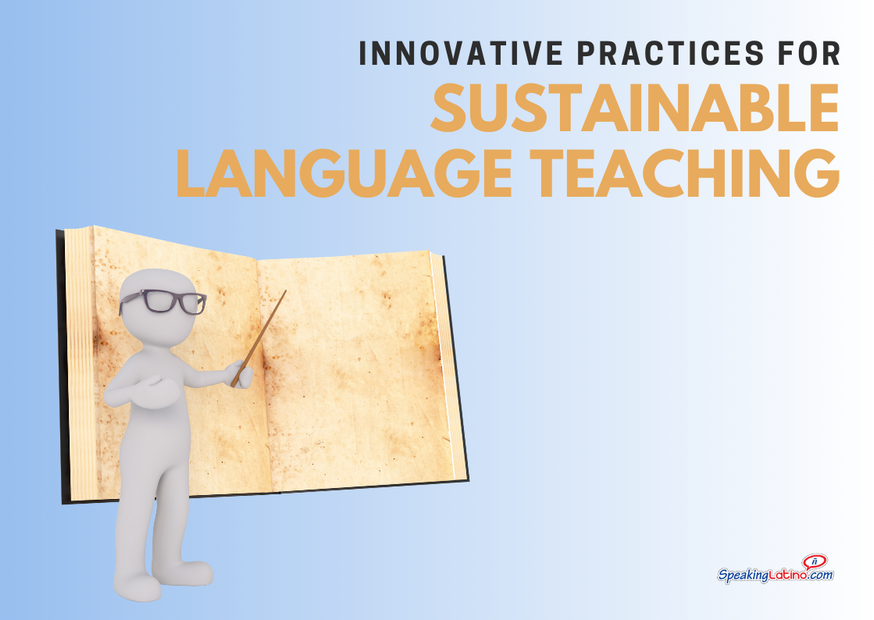
The content of this article is based on the presentation, Making Language Teaching Sustainable by Claudia Elliott, which was part of the World Language Teacher Summit.
The Imperatives of Sustainable Teaching
The intricate challenges of the modern educational landscape, including the increasing rates of teacher burnout and the complex demands of varied student needs, have made the pursuit of sustainable teaching methods imperative. In the field of language education, these challenges are compounded by the specific requirements of facilitating language acquisition and ensuring consistent engagement in the target language. This article explores the principles and practices necessary for establishing a sustainable language teaching framework.
Core Routines: A Foundation for Sustainability
One of the cornerstones of sustainable teaching is the establishment of core routines within the classroom setting. Core routines are not just mere daily procedures but foundational elements that provide structure and reduce the cognitive load for both educators and learners. A class routine starts from the moment students walk into the classroom with a familiar greeting and extends to the closure activity that signals the end of a productive class. These routines can include but are not limited to social-emotional learning checks, independent reading periods, thematic discussions, and reflection activities, such as exit tickets.
Routines create a sense of security and predictability, paving the way for an efficient transition into the target language environment. Over time, these repetitive practices become automatic, allowing students to focus their cognitive resources on language acquisition rather than deciphering classroom procedures. Moreover, routines serve to lessen the decision fatigue experienced by teachers, granting them the mental bandwidth to focus on responsive teaching and fostering deeper connections with their students.
Fortifying Language Acquisition through Interactive Practices
It is vital to emphasize the necessity of engagement and extensive use of the target language within these routines. A classroom atmosphere where target language use is prevalent encourages immersion and enhances language acquisition. A systematic approach employing a predictable classroom routine, such as calendar talks that incorporate personalized questions about daily life and culture, can ensure substantial student engagement. Such interactive practices encourage students to take ownership of the class activities and the language-learning process.
Additionally, frequent opportunities for students to actively participate in dialogue, share about their personal experiences, and connect with cultural content in the target language can increase their investment in the learning process. This interactive engagement is essential for language retention and fosters a sense of community and mutual respect among learners, making the language classroom a dynamic and collaborative space.
Leveraging Student Contributions for Authentic Material
Another approach to sustainable teaching involves the co-creation of class content. Teachers encourage students to actively contribute their ideas and perspectives, making the learning materials more relevant and comprehensible to them. This participatory approach can take multiple forms, such as the implementation of anchor charts, write and discuss activities, and story asking.
Anchor charts serve as a visual collaborative space where students can map out their thoughts on a range of topics, from personal identity to pressing global issues. This approach not only helps in vocabulary retention but also allows students to see their contributions valued and their voices represented in the learning content.
Write and discuss activities further cement the importance of oral input in language learning. By engaging in discussions around pertinent themes (e.g., a song or a story) and then collectively writing about them, students engage in a necessary retrieval process that solidifies their language skills and ensures comprehension.
Story asking is a unique method that invites the entire class to craft a narrative by constructing characters, settings, and plotlines, which not only consolidates linguistic elements learned but also nurtures creativity and camaraderie.
These methods of co-creating content render the learning process more interactive and personalized, thereby increasing student motivation and retention. The content becomes anchored in the students' lived experiences and interests, which substantially enriches the learning material and aids in memory recall.
Empowering Students through Selective Learning Experiences
Teachers also recognize the significant role that student autonomy plays in the sustainability of teaching practices. Providing students with a degree of choice stimulates intrinsic motivation and fosters independent learning skills. In language classrooms, choice can be embedded in various aspects of the curriculum, such as listening, reading, and writing exercises, post-reading activities, and long-term research projects.
The implementation of choice boards allows students to select tasks that align with their learning preferences, such as auditory, visual, or kinesthetic activities. This approach not only caters to differentiated learning styles but also empowers students to take charge of their educational journey.
When students have a voice in deciding the topics for projects or learning activities, they are more likely to engage deeply with the material. This autonomy transforms the language learning experience from a passive reception of information to a dynamic process where each student’s interests and preferences play a pivotal role.
Providing students with a degree of choice stimulates intrinsic motivation and fosters independent learning skills
Sustainability Beyond the Classroom: Crafting Future-Proof Language Education Strategies
Ensuring longevity and sustainability in teaching extends beyond individual classrooms or lessons; it requires a holistic view that encompasses curriculum development, resource management, and professional development. Educators are encouraged to create adaptable content and reusable resources that can serve multiple purposes and class settings. For instance, developing a podcast series on post-reading activities teaches with sustainability in mind by generating various ways to approach a single theme or skill, eliminating the need for constant resource creation.
FAQs About Sustainable Teaching Practices
What are some practical strategies recommended for ensuring high target language use in the classroom?
Some practical strategies recommended for ensuring high target language use in the classroom include:
- Implementing core routines: Establishing consistent routines can reduce decision fatigue for both teachers and students, ensuring a focus on target language use.
- Setting clear expectations: Establishing expectations for target language use and behavior at the beginning of the school year can help create a language-rich environment.
- Providing choices: Allowing students to choose activities that interest them in the target language can increase engagement and language practice.
- Incorporating reading activities: Emphasizing reading in the target language can be an effective strategy for language acquisition and proficiency development.
- Using comprehensible input: Ensuring that the target language input provided to students is understandable and engaging can enhance language learning.
- Regularly reviewing expectations: Consistently revisiting language use expectations and reinforcing them daily can help maintain a focus on the target language.
- Incorporating social-emotional learning: Checking in on students' emotional well-being and creating a supportive classroom environment can facilitate language use and learning.
- Encouraging independent reading: Providing opportunities for independent reading in the target language can improve vocabulary acquisition and reading skills.
- Leveraging student collaboration: Encouraging students to work together in the target language can promote language practice and peer learning.
- Using a variety of resources: Incorporating diverse materials such as music, podcasts, social media, and texts in the target language can cater to different learning preferences and enhance language exposure.
How can educators effectively incorporate choice and autonomy into language teaching to enhance sustainability?
Educators can effectively incorporate choice and autonomy into language teaching to enhance sustainability by:
- Providing options for activities: Allowing students to choose from a variety of language learning activities can increase engagement and motivation.
- Implementing choice boards: Creating choice boards with different tasks or activities in the target language can empower students to select tasks that align with their interests and learning styles.
- Offering project-based learning opportunities: Allowing students to choose topics for projects or assignments in the target language can foster autonomy and ownership of learning.
- Encouraging self-paced learning: Providing opportunities for students to progress at their own pace in language learning tasks can promote autonomy and personalized learning experiences.
- Incorporating student-led discussions: Allowing students to lead discussions or debates in the target language can enhance communication skills and promote autonomy in language use.
- Providing choice in assessment methods: Allowing students to choose how they demonstrate their language proficiency, such as through presentations, written assignments, or multimedia projects, can increase motivation and engagement.
- Facilitating peer collaboration: Encouraging students to work together on language tasks and projects can promote autonomy, collaboration, and peer learning.
- Allowing for flexible learning pathways: Providing options for students to choose learning pathways or resources based on their interests and learning goals can enhance motivation and sustainability in language learning.
- Incorporating student feedback: Seeking input from students on their learning preferences, interests, and needs can help educators tailor language teaching practices to promote autonomy and sustainability.
- Fostering a supportive learning environment: Creating a classroom culture that values student voice, choice, and autonomy can empower students to take ownership of their language learning journey and enhance sustainability in language teaching.

Ensuring longevity and sustainability in teaching requires a holistic view that encompasses curriculum development, resource management, and professional development
What role does student engagement play in maintaining a sustainable language teaching environment?
Student engagement plays a crucial role in maintaining a sustainable language teaching environment by:
- Fostering motivation: Engaged students are more likely to be motivated to participate actively in language learning activities, leading to sustained interest and progress.
- Enhancing learning outcomes: When students are engaged in the learning process, they are more likely to retain information, practice language skills, and achieve proficiency in the target language.
- Promoting language use: Engaged students are more inclined to communicate in the target language, both inside and outside the classroom, which can contribute to language fluency and sustainability.
- Encouraging participation: Student engagement encourages active participation in language learning tasks, discussions, and activities, creating a dynamic and interactive learning environment.
- Building a sense of community: Engaged students contribute to a positive classroom atmosphere where collaboration, peer support, and shared learning experiences thrive, enhancing the sustainability of language teaching practices.
- Supporting autonomy: Engaged students are more likely to take ownership of their learning, make choices about their language learning journey, and engage in self-directed language practice, promoting sustainability in language acquisition.
- Increasing enjoyment: When students are engaged in language learning activities that interest and challenge them, they are more likely to enjoy the learning process, leading to sustained engagement and commitment to language learning.
- Facilitating feedback and reflection: Engaged students are more receptive to feedback, reflection, and self-assessment, which are essential components of sustainable language teaching practices that promote continuous improvement and growth.
- Enhancing communication skills: Through active engagement in language activities, students have more opportunities to practice speaking, listening, reading, and writing in the target language, leading to improved communication skills and language proficiency.
- Promoting lifelong learning: By fostering student engagement in language learning, educators can instill a love for languages and a desire for continuous learning, supporting sustainable language teaching practices that extend beyond the classroom.
Navigating the Journey Toward a Sustainable Pedagogy
In pursuit of a sustainable teaching paradigm, instructors are increasingly aiming to control the controllable, streamline classroom procedures, and engage students meaningfully in the learning process. By establishing core routines, co-creating content, and fostering student autonomy, language teachers can build a resilient framework that withstands the rigors of the modern educational climate. Such practices not only alleviate the pressures on educators but also create enriched learning environments where students thrive and educators maintain their passion for teaching. As the journey toward sustainability in language teaching evolves, it is imperative to engage in continuous dialogue and share strategies within the professional community, fostering a collective advancement towards more efficient and effective language education practices.